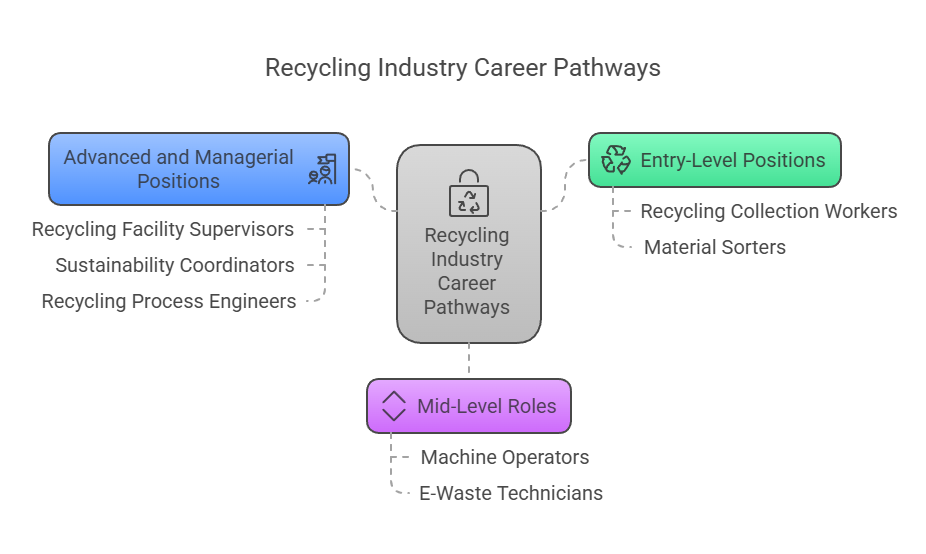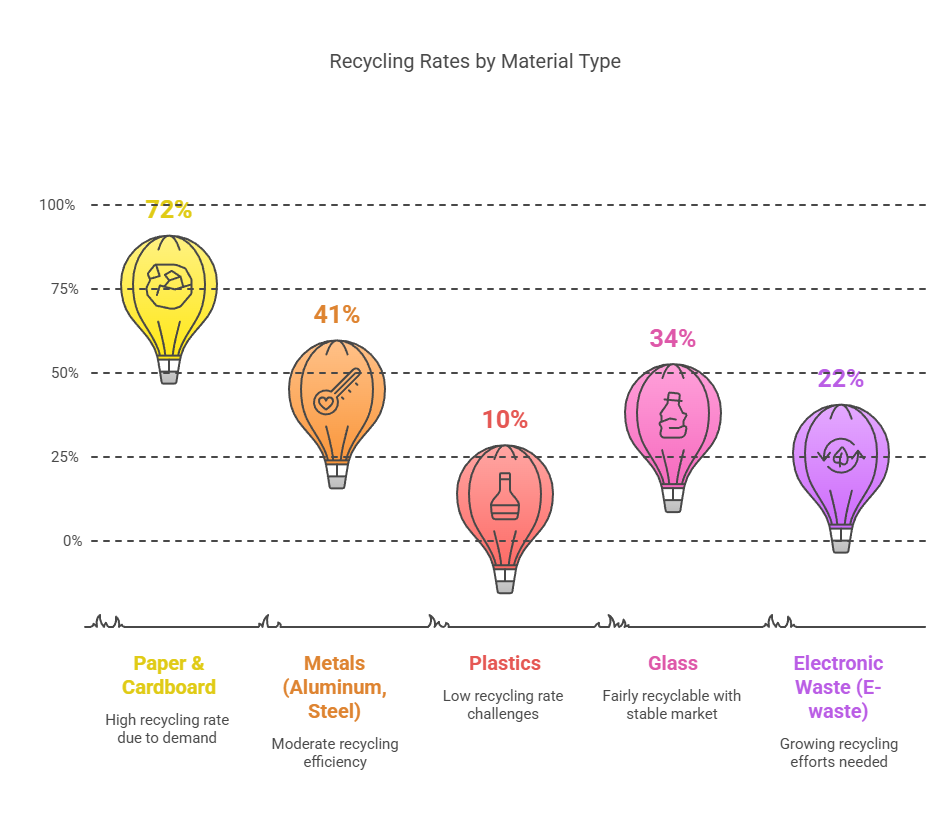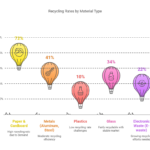The recycling industry continues to be a cornerstone of Canada’s efforts to reduce landfill waste, conserve resources, and protect the environment. At the heart of this system are recycling workers—professionals who sort, process, and manage recyclable materials, ensuring Canada remains on a path to a more sustainable future. Their work helps divert valuable materials from landfills, reduces pollution, and conserves finite natural resources.
The Scope of Canada’s Recycling Industry
Market Size and Economic Impact
- Market Valuation: As of 2024, the Canadian recycling industry is estimated to be valued at approximately CAD 9.0 billion, reflecting modest but steady growth.
- Employment: More than 62,000 people work in recycling and related sectors across the country, a slight uptick from prior years.
- Growth Projections: Between 2025 and 2030, the industry is projected to maintain a 3.8% compound annual growth rate (CAGR), driven by federal and provincial programs targeting waste reduction and circular economy initiatives.
Recycling Rates by Material in Canada
Below is an approximate snapshot of national recycling rates based on data compiled between 2023 and 2024 from various provincial programs and Statistics Canada:
| Material | Recycling Rate |
| Paper & Cardboard | 72% |
| Metals (Aluminum, Steel) | 41% |
| Plastics | 10% |
| Glass | 34% |
| Electronic Waste (E-waste) | 22% |
While the numbers show slight improvements for plastics and electronic waste, both still face significant challenges, underscoring the need for better infrastructure and consumer outreach.
Who Are Canada’s Recycling Workers?
Recycling workers in Canada manage a diverse range of tasks that generally fall into three main categories:
- Collection Workers
- Operate specialized trucks to gather recyclable materials from homes, businesses, and industrial sites.
- Transport collected recyclables to sorting or processing facilities.
- Sorters and Processors
- Manually or mechanically sort materials, eliminating contaminants to adhere to industry quality standards.
- Work primarily in Material Recovery Facilities (MRFs) or similar large-scale sorting centers.
- Facility Operators and Technicians
- Maintain machinery like balers, conveyor belts, and crushers.
- Ensure day-to-day efficiency and safety of recycling equipment and processes.
Employment Statistics
- Number of Recycling Workers: Across private companies and municipalities, approximately 62,000 Canadians are employed in recycling-related roles, according to the latest provincial and federal data.
- Average Annual Wage: Depending on experience, location, and job responsibilities, annual wages typically range from CAD 38,000 to CAD 52,000. Provinces with higher living costs, such as British Columbia and Alberta, tend to offer higher compensation.
- Projected Job Growth: As environmental awareness rises, employment in the recycling sector is expected to grow by 4% to 5% through 2030, particularly in urban centers with strong zero-waste and circular economy targets.
Workplace Risks and Safety Concerns
The environmental value of recycling is significant, but workers do face daily occupational hazards:
- Exposure to Hazardous Materials
Items like batteries, chemicals, and medical waste can mistakenly end up in recycling streams. - Injuries from Heavy Machinery
Crushers, balers, and conveyor systems can be dangerous if strict safety protocols are not followed. - Repetitive Motion Strain
Repeated sorting and lifting can lead to musculoskeletal issues. - Airborne Contaminants
Dust, mould, and fumes often circulate in enclosed facilities, posing respiratory risks.
Per the Canadian Centre for Occupational Health and Safety (CCOHS), the recycling sector’s injury rate remains slightly above the national private-industry average, at about 5 injuries per 100 workers. This has led to:
- Enhanced use of personal protective equipment (PPE).
- Adoption of machinery equipped with advanced safety features.
- Comprehensive training focused on hazard identification and prevention.
Staffing and Workforce Trends in Canada’s Recycling Industry
A dedicated workforce underpins every tonne of material recycled. From truck drivers to engineers, the Canadian recycling sector is adapting swiftly to new technologies, shifting labor markets, and evolving policy landscapes.
Job Roles and Career Paths in Recycling
There is a broad spectrum of opportunities available, from entry-level to highly specialized roles:
- Entry-Level Positions
- Recycling Collection Workers – Typically require a valid provincial driver’s license (Class 3 or 5, often with air brake endorsement). Median salary: ~CAD 40,000.
- Material Sorters – Perform manual sorting of recyclable materials, often in busy facility settings. Median salary: ~CAD 35,000.
- Mid-Level Roles
- Machine Operators – Operate and maintain balers, crushers, and conveyor systems. Median salary: ~CAD 48,000.
- E-Waste Technicians – Specialize in retrieving metals and components from electronics. Median salary: ~CAD 52,000.
- Advanced and Managerial Positions
- Recycling Facility Supervisors – Manage daily operations and ensure regulatory compliance. Median salary: ~CAD 65,000.
- Sustainability Coordinators – Implement recycling and waste reduction strategies within corporations. Median salary: ~CAD 72,000.
- Recycling Process Engineers – Develop new methodologies and technologies to improve recycling efficiency. Median salary: ~CAD 85,000+.
Hiring Challenges in the Canadian Recycling Industry
Labor Shortages and Turnover
- High Physical Demands: Sorting, hauling, and lifting materials lead to fatigue and potential injuries.
- Safety Issues: The risk of injuries can discourage long-term retention.
- Misconceptions About the Industry: Perceptions of low-skill, low-wage work persist, despite avenues for career growth.
Strategies to Address Shortages
- Offering competitive pay, signing bonuses, and strong benefits packages.
- Enhancing safety training and workplace ergonomics.
- Highlighting clear career pathways, from entry-level to supervisory and technical roles.
Skills Gap and Workforce Development
Automation and AI-driven sorting technology continue to reshape job requirements:
- Technical Expertise: Facilities need workers who can manage robotics, data systems, and maintenance tasks.
- Community College & Trade School Partnerships: Institutions increasingly offer specialized programs in automation and waste management.
- Apprenticeships & Certifications: Employers and provincial governments often collaborate on practical, skill-based training.
Diversity and Inclusion in Canada’s Recycling Workforce
While historically male-dominated, the recycling sector is seeing progressive efforts to diversify:
- Focused Recruitment: Municipal and private organizations partner with community groups to engage women, Indigenous peoples, and newcomers.
- Language & Training Supports: Many facilities provide multilingual instructional materials and onsite language classes to accommodate newcomers.
- Mentorship & Leadership Programs: These initiatives are designed to increase representation of underrepresented groups in managerial and specialized technical roles.
A diverse workforce not only mirrors Canada’s multicultural identity but also encourages innovative problem-solving and team collaboration.
How Job Seekers Can Enter the Canadian Recycling Industry
Steps to Getting Hired
- Research Potential Employers
- Municipal waste services (e.g., Toronto, Vancouver, Edmonton) or private environmental service firms.
- Monitor job boards like Indeed, Workopolis, LinkedIn, and provincial government sites.
- Obtain Relevant Certifications
- Waste Management Training: Some provinces offer official programs in waste and recycling operations.
- Health & Safety Endorsements: OHS and forklift certifications can significantly improve employability.
- Look for Training & Apprenticeship Programs
- Many recycling operations provide on-the-job training for machine operators and sorting specialists.
- Provincial grants occasionally fund “green job” training for those looking to transition into sustainability sectors.
- Plan for Long-Term Advancement
- Positions like supervisor, coordinator, or engineer often require extra education in areas such as environmental science, business management, or engineering.
Employer Strategies for Talent Attraction and Retention
Best Practices for Canadian Recycling Employers
- Offer Competitive Compensation & Benefits
- Above-average wages reduce turnover.
- Extended health benefits, RRSP matching, and paid leave are becoming standard.
- Emphasize Safety & Well-Being
- Investments in PPE, updated machinery, and ergonomic aids can lower injury rates.
- Mental health support and counseling services contribute to a supportive workplace culture.
- Encourage Professional Growth
- Tuition reimbursement or certification sponsorship fosters loyalty and skill enhancement.
- Internal promotion pipelines give employees clear advancement opportunities.
Challenges Facing Canada’s Recycling Workers and the Industry
Contamination Rates
Nationwide, contamination rates in recycling streams generally fall between 15% and 25%. Non-recyclable waste drastically increases operational costs and can force entire truckloads to landfills.
Fluctuating Commodity Prices
- Export Restrictions: Ongoing global changes, such as import bans in major receiving nations, continue to reshape Canada’s export landscape.
- Price Volatility: Demand for metals, plastics, and paper can shift quickly, impacting revenue for recycling facilities.
Automation and the Evolving Workforce
Robotic sorters and AI-powered equipment can boost quality and efficiency but may reduce the need for certain manual jobs. On the flip side, these technologies create new openings for individuals adept at technical maintenance and system oversight.
The Future of Recycling Jobs in Canada
Policy-Driven Growth
- Extended Producer Responsibility (EPR): Provinces like British Columbia and Ontario continue to expand EPR programs, compelling manufacturers to handle post-consumer recycling.
- Municipal Zero Waste Targets: Cities such as Vancouver, Montreal, and Calgary are setting ambitious waste-reduction goals.
Surging E-Waste Recycling
The volume of discarded electronics is rising. Specialists in extracting metals from devices are particularly sought after, especially as the market for lithium, cobalt, and precious metals expands.
New Green Careers
As the circular economy concept gains traction, emerging roles include:
- Waste Auditors: Identify and reduce inefficiencies in corporate and municipal waste streams.
- Sustainability Planners: Oversee long-term strategies for waste minimization and material reuse.
- Recycling Process Engineers: Design next-generation solutions for sorting and material recovery.
FAQ: Frequently Asked Questions
- Is recycling mandatory across Canada?
Requirements vary by province and municipality. Most regions do at least require curbside collection or depot-based programs for paper, plastics, and metals. - What credentials do I need to become a recycling worker?
A high school diploma is typical for entry-level roles; machine-oriented positions usually require additional certifications (e.g., forklift operation, OHS training). - How can I move up within the industry?
Acquiring more specialized certifications, attending environmental science courses, or gaining supervisory experience can open doors to higher-paying and managerial roles. - How safe are recycling jobs?
With robust adherence to CCOHS guidelines, proper PPE, and consistent training, the risk of injury is significantly mitigated—even though certain roles are physically demanding. - Do global market trends affect Canadian recycling jobs?
Yes. Shifts in commodity prices can impact profitability, but strong domestic policies and local markets help buffer sudden changes in global demand. - Which areas in recycling are growing the fastest?
E-waste processing, advanced plastics recycling (e.g., chemical recycling), and circular economy innovation are among the fastest-growing niches. - Is it possible to hire temporary recycling workers?
Definitely. Specialized staffing agencies offer short-term labor solutions tailored to seasonal demands or specific projects.

Websites Referenced for Canadian Data
- Statistics Canada (www.statcan.gc.ca)
- Environment and Climate Change Canada (www.canada.ca/en/environment-climate-change.html)
- Canadian Centre for Occupational Health and Safety (www.ccohs.ca)
- Government of Canada (www.canada.ca)
- Provincial Ministry of Environment Websites (e.g., Ontario’s Ministry of the Environment, Conservation and Parks)
Partnering with RSS Staffing
If you are a Canadian employer seeking temporary or contract-based workers for your recycling operations, RSS Staffing is here to assist. Our extensive network of qualified candidates spans Ontario, Quebec, British Columbia, Alberta, and more. We specialize in matching you with:
- Pre-screened, Skilled Workers: Ready to meet the physical and technical demands of a recycling facility.
- Flexible Contracts: Whether you need short-term, seasonal labor or longer-term staffing, we adapt to your timelines.
- Ongoing Support: We stay involved to ensure each placement is smooth and productive.
Final Thoughts
Canada’s recycling sector shows no signs of slowing. Government policies, corporate sustainability initiatives, and an environmentally conscious public are propelling steady industry growth. Meanwhile, recycling workers remain on the front lines, making tangible contributions to cleaner communities and a more sustainable economy.
By prioritizing worker safety, investing in emerging technologies, and establishing clear career pathways, Canadian recycling firms can continue driving innovation and environmental progress. Whether you are seeking new career opportunities or planning to bolster your recycling workforce, the industry stands ready with a wealth of prospects and impact.









